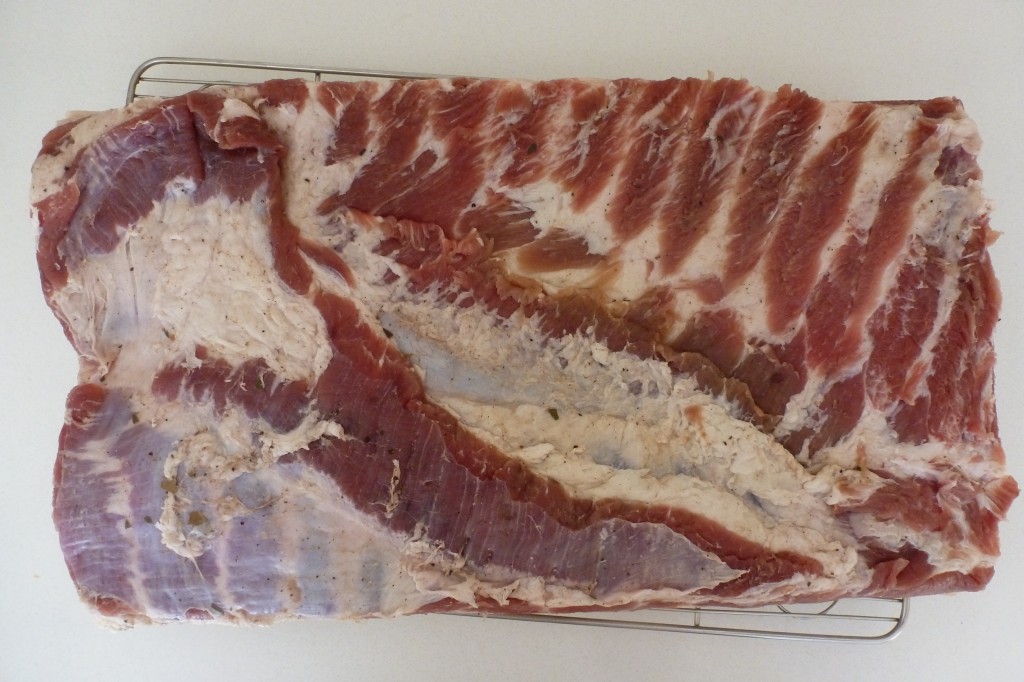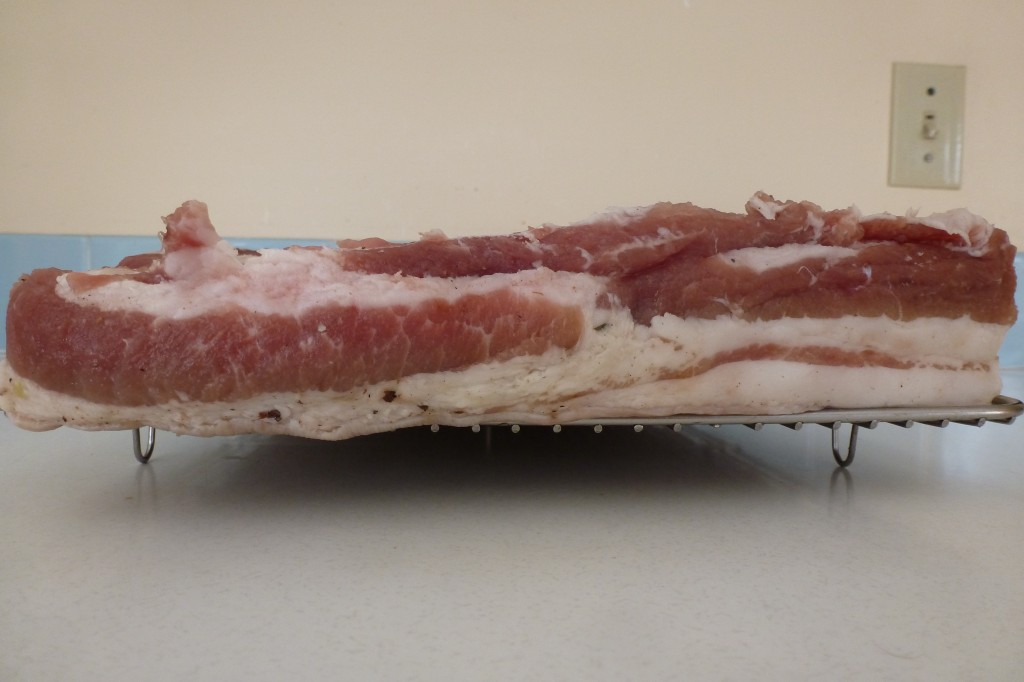The word “bacon” usually refers to pork belly that has been cured and then smoked. An exception is back bacon, which is cured pork loin. “Canadian bacon” is what Americans call back bacon that has been smoked.
Below are some notes on making bacon at home.
A Quick Tour of the Pork Belly
Before I started buying pork by the side, I ordered slabs of belly from Irvings Farm Fresh. A 5 lb slab was typically around $25.
Below is a slab of pork belly. You’re looking at the inside of the pig; the opposite side is covered with skin. The right side of this slab would have connected to the front shoulder of the hog. The left side would have connected to the hind leg. The top was once connected to the loin, and the bottom to another belly slab at the sternum of the pig. Do you see the diagonal line that runs roughly from the top left to the bottom right? That would be the perimeter of the rib cage. The section to the top right once clung to the pig’s ribs, and you can actually see the pattern of the ribs in the vertical lines of meat and fat. The lower left section of the slab was outside the rib cage. The boundary between those two sections is the diaphragm, though the actual diaphragm muscle has been trimmed off.
Since we’re discussing anatomy, I might as well point out that the different parts of the belly have different eating and cooking qualities.
Here is a picture of the right end of the above belly slab, that is, the side once attached to the front shoulder of the pig. This is good bacon, though perhaps a little lean as far as these things go.
Here is the left side of the belly, which connected to the leg. You can see that it doesn’t have nice, alternating layers of meat and fat, but rather a few isolated muscles separated by a large amount of fat. I find this “leg end” bacon too fatty to be simply fried and eaten for breakfast. I would rather, for instance, chop this end, fry it to render out the fat, then cook Brussels sprouts or beans in the same pan.
Finally is a cross-section from the middle of the belly. Here we have meat and fat in almost equal proportions, and in the nice, alternating, streaky pattern we expect from bacon. This is the best part of the belly to be fried for breakfast.
I leave the skin on the belly until after it is smoked. It comes off easier when the bacon is warm and can be saved and added to, say, a crock of brown beans.
Curing
Bacon requires sodium nitrite (aka curing salt, tinted cure mix, pink salt, read more here) for its characteristic flavour and colour, and to discourage microbial growth during smoking.
I use the basic cure recipe from Charcuterie, which consists of kosher salt, pink salt, and white sugar. I rub this mixture onto the surface of the pork belly, which I then set in a shallow plastic tub.
The pork belly sits in the fridge for about a week. It’s best to flip the slab and redistribute the cure twice over that period. When I first made bacon I thought the meat would lose a lot of liquid because of the salt. In reality, only a couple thin puddles form around the belly.
After a week the belly is rinsed clean and patted dry, after which it is set on a wire rack, uncovered, in the fridge to form a “pellicle”, a tacky surface that aids in the absorption of flavour during smoking. This takes several hours.
Smoking on the Barbecue
Smoking meat is without exaggeration one of the most rewarding food experiences. The smell is bewitching, and the meat goes through a remarkable transformation in taste and colour. I make a few aluminum foil packets, each filled with two handfuls of wet maple chips and one handful of dry, then punch holes on both sides of the packets with a fork. The packets are set directly onto the right-hand barbecue burner, which is kept on its lowest setting. This starts the chips smoldering while maintaining the ideal hot-smoking temperature of 250°F in the rest of the barbecue. I try to keep the cured belly on the left-hand side so as not to be over direct heat. If I’m doing more than one slab, I’ve found that putting a piece high above the wood chip packets is okay, too.
The Result
Homemade bacon has a denser, coarser, and all in all more satisfying texture than the convenience store variety. The taste is much more robust: smoky and piquant. Thin, watery bacon: one more supermarket product that has been ruined for me.





